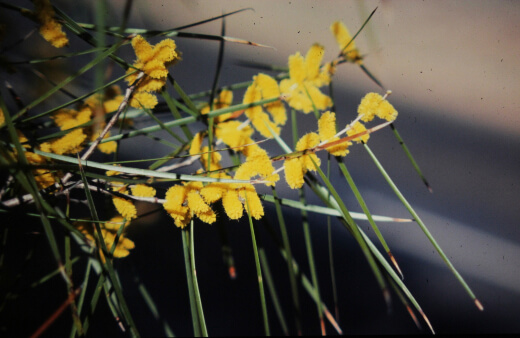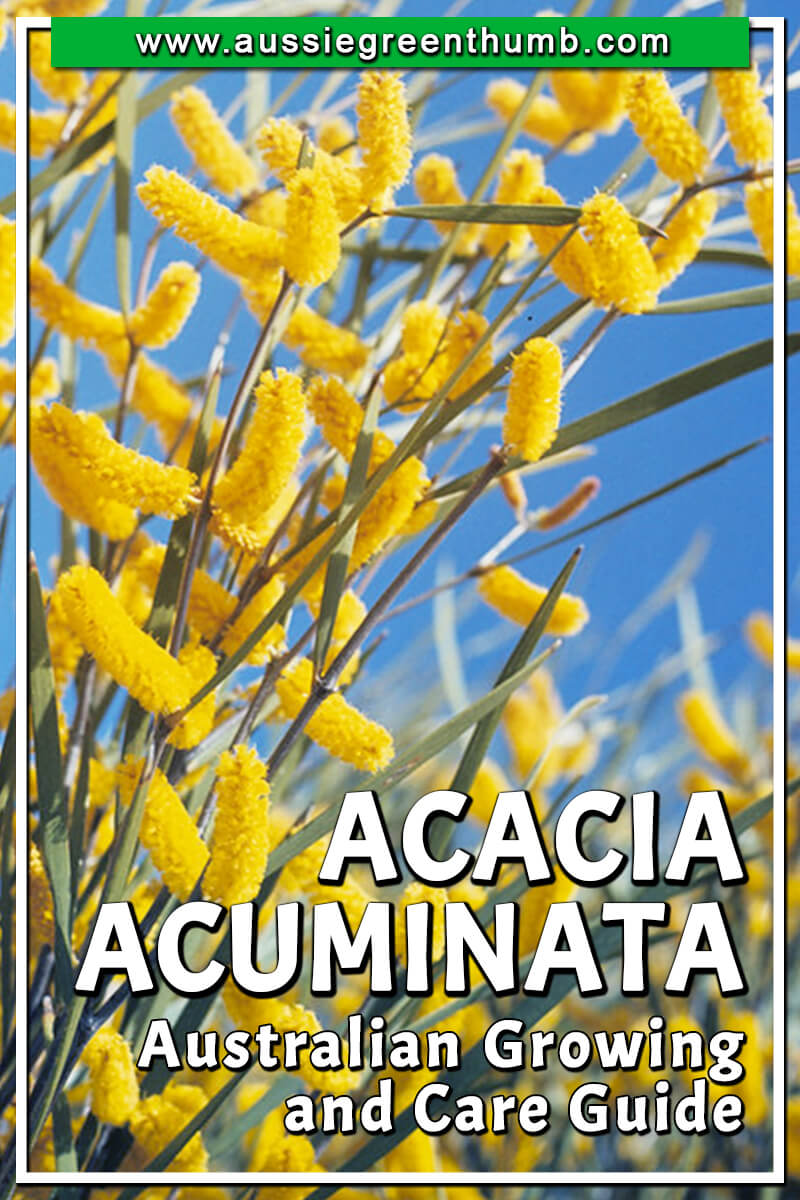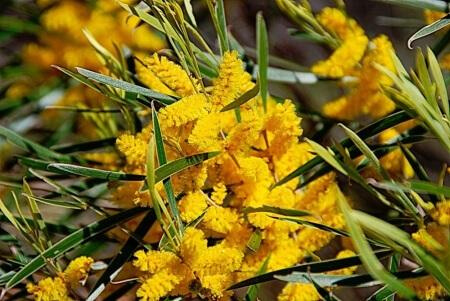Wattle trees are incredibly common in Australian gardens, especially as they grow so happily in harsher conditions. Acacia acuminata or Raspberry jam wattle is a real Aussie favourite, known for its fantastic foliage and incredibly valuable seeds.
Bright, bold and hardy, the Acacia acuminata is an excellent addition to most gardens. Here is everything you need to know to cultivate, care for and grow Acacia acuminata at home.
More...
What is Acacia acuminata?
Family: Fabaceae
Genus: Acacia
Species: A. acuminata
Common Name: Raspberry Jam Wattle
Flower Colour: Yellow
Foliage Colour: Green
Growth Habit: Small Tree to 5m
Flowering: Winter to Spring

Photo: Russel Dahms on Westflora
The Acacia acuminata is a common, West Australian native belonging to the Fabaceae family. This shrub-like tree produces brilliant yellow blooms and super-food-like seeds, making it an attractive option for many Aussie gardens.
Accuminata trees are also incredibly drought, frost and salt tolerant, meaning they will grow happily, even in colder or coastal regions. More affectionately known as the jam wattle, this smaller tree was often used in Aboriginal food and lifestyle.
Seeds were usually ground up and turned into a cake which cooks on the fire. The strong hardwood, said to smell like raspberries, was used to fashion a variety of structures and weapons.
Other common names include:
- Raspberry Jam Wattle
- Fine Leaf Wattle
- Mangart
Not only do raspberry jam trees have remarkable wood, but the curious, yellow blooms and long seed pods also offer a visual delight throughout spring and summer. This species also produces a bright orange resin, which is entirely edible.
Like most wattles, the Acacia acuminata is a nitrogen fixer, meaning it can help balance out nitrogen-rich soils and support many of your other garden plants. It also has a shallow root system, meaning it can grow in sandy or eroding soils.
How to Start Growing Acacia acuminata
One of the easiest methods to start growing A. acuminata is from seed. While it may take a while to become established and over two years for your accuminata to begin flowering, the wait is worth it. Once established, your jam wattle really won't require much attention.
Ideally, you will want to start growing your raspberry jam wattle in a spot that gets plenty of sunlight. While they are adaptable in partial shade, full sun is often the better option.
Jam wattle trees prefer loose, well-draining soil. However, they're not always very picky and will likely adapt in most soil conditions, provided there is only an average amount of humidity.
Acacia acuminata Seeds
Not only are acuminata seeds incredibly nutritious, but they also offer a straightforward cultivation option. Seeds can be store-bought or picked directly from an existing tree. Mature pods will carry as many as 35 viable seeds.
It is important to note, however, that stored seeds will require scarification. Simply leave your seeds in warm water for approximately 12 hours, then sow directly into the soil.
Sowing should be undertaken in early spring.
Simply:
- Sow seed 5 mm underneath the surface of the soil.
- Keep soil moist and warm during germination. Greenhouse conditions, with temperatures reaching 25°C is ideal.
Germination should only take about 3 to 4 weeks. Avoid re-planting your seedling too early. Ideally, you'll want to wait until after its first winter to re-plant.
How to Care for Acacia Acuminata
Raspberry jam trees usually flower throughout spring, followed by seeds that can be harvested throughout the summer.
As it is a drought-tolerant plant, it won't require much supplementary watering, especially in high-humidity areas. In seasons with heavy rainfall, avoid watering at all.
While jam wattle trees do enjoy a little feeding during the spring, it is best to use fertiliser sparingly. Some experts recommend feeding your acacia trees with an orchid fertiliser every few months in the first year of growth to promote rigorous roots.
As this species is fairly slow growing, in gardens reaching only 5 metres high, you won't need to worry about pruning too often. Avoid removing any young leaves and focus only on dead growth.
Problems, Pests & Diseases
Wattle trees aren't overly problem-prone, so you shouldn't come across many issues when growing raspberry jam wattle in the right conditions. When weakened, your jam wattle may become susceptible to certain parasites or a gall rust infection. Treat pests with a natural insecticide and gall rust with a quality fungicide.
What is important to note is that the jam wattle will likely bring quite a few feeders to your garden including, birds, bees, butterflies and some grazing herbivores. These feeders often won't cause any damage to your plant.

Source: Inaturalist.org
Acacia acuminata Uses
A. acuminata have a long list of gardening applications and benefits, making them a very popular choice. A. acuminata can be used to:
- Attract wildlife.
- Be a feature plant.
- Create a hedge.
- Add screening for additional privacy.
- Provide shade.
- Provide a windbreaker.
Plus, Acacia acuminata are perfect partner plants for quandong or sandalwood so be sure to check our comprehensive growing guide on quandong.
Beyond their gardening applications, jam wattle trees are often used for their wood. The wood is tough, closely grained, and durable as well as termite resistant. It is used extensively for crafting, furniture, and fencing with attractive reddish colour and deep patterned grain.
More so, the seeds have a wide range of benefits, carrying 45% protein, 28% fats and only 15% carbohydrates. The seeds can be ground up and turned into flour that can be used in cooking and baking.
Acacia has many uses. Ingesting the seeds is also believed to assist with diarrhea, reduce internal bleeding and improve low blood sugar.
The rich orange resin has also been used traditionally to make tea, believed to have a range of medicinal benefits.
Acacia acuminata Frequently Asked Questions
How long does Acacia acuminata take to grow?
A. acuminata is slightly slower to establish than most species of Acacia, but it can bear fruit after just two years if you’re lucky. After the first couple of years, its roots will be reasonably well established in the soil, and it can grow around 40-50 cm per year on good, free-draining soil.
How tall is Acacia acuminata?
A. acuminataa can be hedged by harsh pruning, and kept to pretty much any height, but at its full natural height, A. acuminata can grow up to 7m high, though in most cultivated settings will only reach 3m tall.
What are Acacia acuminata leaves called?
A. acuminata has leaves called phyllodes, not true leaves. Its leaves are actually modified leaf stems (petioles) which serve the same function as leaves, but they are flat and narrow which helps them to cope with intense summer heat thanks to their smaller surface area which stores less water, and helps them resist pest damage too.
Why is Acacia acuminata called the Jam Wattle?
A. acuminata has an intense fragrance of raspberry jam when the bark is removed, or the branches are cut. Its seeds can be harvested and are often cooked into preserves to add flavour, but the name comes from the scent of the wood, rather than any culinary use.
What are other names for Acacia acuminata?
As well as its scientific name (Acacia acuminata), this wattle tree is also called the Raspberry Jam Wattle or, informally, tucker bush thanks to its incredibly varied culinary use and as a readily available bush tucker.
How do you prepare Raspberry Jam Wattle?
Raspberry Jam Wattle, A. acuminata, is simple to prepare for eating. The seeds have a spiced earthy flavour, and simply need to be dried and ground up over food, or mixed into cake batters and preserves to add a cinnamon-like flavour.
Where can I find Acacia acuminata?
A. acuminata is a fairly common species of wattle, found growing naturally throughout Western Australia, and particularly prevalent to the East to Balladonia. Acacia wattle seeds are easy to germinate, or young plants are available in garden centres in late winter and spring.
How do you germinate Acacia acuminata?
To germinate A. acuminata, fill a heat-proof container with hot (not boiling) water and leave them to soak overnight to soften their shells. Sow them 5mm deep in free-draining potting mix, and leave them in full sun for 2-4 weeks. Try to keep the soil evenly moist, but not damp.
Where is the best place to plant Acacia acuminata?
A. acuminata can cope with shade but prefers full sun. Its foliage is specially adapted for direct, hot, summer sun, and is able to cope with the wind more than most acacias, but it's still worth trying to find some shelter if you live high up, or near the coast where winds can be bitter and harsh.
How deep do Acacia acuminata roots go?
A. acuminata roots can go down about 15m into the soil, but they will not push through concrete or stone underground and are not considered damaging to property.
However, modern builds and pools may be affected by semi-mature trees, so aim to plant them at least 10m from a pool.
Can you propagate Acacia acuminata from cuttings?
A. acuminata can be propagated easily from cuttings. One of the hardest things about taking cuttings is that foliage loses moisture and stresses the newly forming roots.
Thanks to the narrow phyllodes of A. acuminata, cuttings tend to take well and do not suffer too much through warm summers.
Does Acacia acuminata improve soil?
Like all acacias, A. acuminata is a nitrogen fixing plant. There are thousands of species and genera of plants in the world that efficiently fix nitrogen to the soil, but acacias also draw in other nutrients.
Those nutrients and minerals which are not used by the plant leech back into the soil, and when the tree dies (usually after 30 years) the soil will be richer, looser, and better for planting.

Wrapping Up our Acacia acuminata Guide
Keep a careful eye on soil conditions; growing jam wattle trees are easiest done in fast-draining, loose soil. Don't feel too terrible if you forget to water your jam wattle, it shouldn't affect them too much. Just supplement occasionally with a bit of water, and in the spring, a small amount of fertiliser.
Are you considering growing some other Australian natives in your garden? Check out our ultimate Australian native plant guide. Whichever reason you choose to grow Acacia acuminata in your garden, you'll be able to enjoy an abundance of colour, greenery and wildlife.
Published on January 14, 2023 by Nathan Schwartz
Last Updated on February 22, 2024






Thank you, very informative post.
I am hoping to keep my acacia in a large-ish pot rather than the ground as I am currently renting, would this be a problem?
Hey Rob,
Thank you so much for your question! Acacia accuminata is a beautiful and rewarding native tree, and we hope you get a lot of joy from yours. Unfortunately, they have a very strong and fast-growing root system, and quickly outgrow containers, so they are not recommended for pots.
Even young plants will start shooting roots out of the container within a few months and having a constrained growth area can stunt the plant or even cause it to root into the ground or paving below.
Instead, we recommend simply planting the tree in the yard (with permission) and enjoying it while you live there. At least it will help create a beautiful space for the next residents and will add a little more native flora to the area.
If you’d like too try out some native plants that thrive in containers, we recommend planting acacia cognata (Limelight), banksia spinulosa, kangaroo paws, acacia glaucoptera, callistemon (Little John), or rosemary grevilliea.
Kind regards,
Gary Clarke